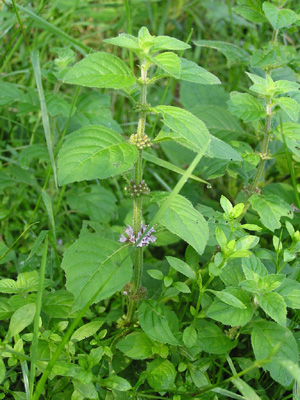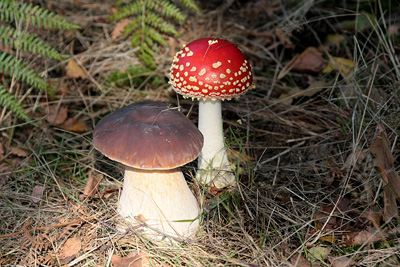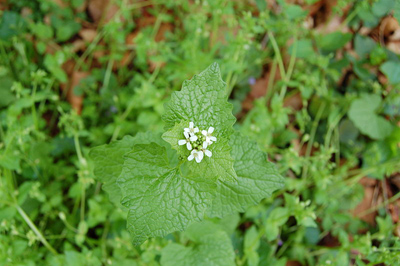Foraging for Wild Edibles:
A Practical Approach

By Filip Tkaczyk
Have you ever been curious about foraging for wild edibles? There are many ways to go about it, and some are certainly more effective and enjoyable than others. The most practical approach to wild edibles is incorporating them into your daily life. Here are some considerations to make next time you want to go out and forage.
Why Forage?
The benefits of foraging for wild
edibles are as varied as the reasons why people do it. Foraging is an
active, participatory way of connecting with the living landscape. It
encourages closer observation and sensory engagement, and can help
engage people of all ages in more positive physical experiences. Wild
edibles add beneficial diversity to our diet, both in flavor and
nutrition.
Having knowledge of local wild edibles will also
engender greater confidence in your ability to be resilient in
challenging times, such as potential survival situations, whether in
urban or wilderness contexts.
What to forage for?
Foraging for wild edibles can include gathering things such as wild plants (or specific parts of them), wild mushrooms and animals as food. Here are some great further sources for specific plants or plant parts to forage for:
Samuel Thayer's excellent website is a good resource for wild food foraging: foragersharvest.com
Also check out these articles:
- edible berries article
- edible wild mushrooms article

If you are concerned about poisonous mushrooms, learn more by reading this:
- Poisonous Mushrooms Article
Some
plants are particularly good to focus on as ones to rely on in a
survival situation: survival plants article. More specifically, here
are some that are excellent ones to consider becoming more familiar with
in desert regions: plants in the desert article.
How far to travel?
How far you travel when foraging for wild edibles is a serious question. The best place to start is generally right where you live, so consider doing some urban foraging.
There is always some kind of wild edible nearby, even in and around big
cities. It is more sustainable and practical to harvest wild foods from
your local area. Although you may also want to wander further afield.
Sometimes certain particularly tasty and nutritious wild foods require
more time and travel but end up being worth the effort.
I spend
time every fall driving 50 miles from my house to seek out certain
delectable wild edible mushrooms. This is a significant distance to
travel, but I also tend to get a great deal of enjoyment out of being in
the forest and looking for these mushrooms. Also, if my timing is
right, I may come back home with enough wild mushrooms to last my family
until next fall. I go to familiar locations I have harvested from for
years and often foraging for wild edibles becomes a social event.
Be More Prepared For Your Next Outdoor Adventure!

Don't leave home without knowing these six essential survival skills. Our free survival mini guide reveals the strategies of:
- Shelter & fire to prevent the number one cause of death
- Obtaining clean water to avoid life-threatening dehydration
- Common wild survival foods and other critical skills!

Harvesting Ethics
It
is always good to be considerate of your effect on the landscape you
are harvesting from and on the specific organisms you are harvesting.
Whenever possible, minimize your impact to the landscape by:
- Avoid trampling sensitive and slow-growing species in the process of harvesting, such as stepping on trillium species.
-
Harvest sustainably by taking only a fraction of what is there, leave
the rest to reproduce and feed others. A good practice is to harvest 1
in 20 plants, or 1 and 4 fruits (such as berries).
- Learn about what benefits the growth of the species you harvest, and aid them in growing more abundantly if you can.
This benefits not only the species you are harvesting, but everything
else in relationship to it, including other animals, plants and fungi.
An example of this is when harvesting late season stinging nettle stalks
for cordage, strip off and drop the seeds at the site of harvesting to
encourage more the next year.

- Remove invasive species, which may compete with or choke out the species you are harvesting. Some wild edibles are themselves invasive, and so harvesting larger quantities of them can benefit the area. One example of an invasive that is also a good wild edible is garlic mustard (Alliaria petiolata).
- Create or become part of a community of people that practice foraging for wild edibles. Part of stewardship is passing on the culture of proper harvesting ethics to the next generation and sharing the knowledge with your community. A great way to do that is have a wild foods potluck with your family, friends and neighbors.
- Consider creating or supporting community spaces for wild foraging in your neighborhood and in your yard. Weedy green spots in neighborhoods, pea patch gardens and greenbelts can all serve as potential spaces for stewarding wild edible greens.
Wild Foraging Hazards
There are a few hazards to consider when foraging for wild edibles. First, make sure to only consume plants you have properly identified and avoid poisonous plants.
A handful of plants are particularly hazardous, these include some of the most toxic plants in North America: Foxglove (Digitalis purpurea), Poison hemlock (Conium maculatum), Water hemlock (Cicuta douglasii), Poison oak (Toxicodendron diversilobum), Poison sumac (Toxicodendron vernix), Poison ivy (Toxicodendron radicans), Oleander (Nerium oleander), Castor bean (Ricinus communis), Larkspur (Delphinium ssp.), Yew (Taxus ssp.) and Rhododendrons (Rhododendron ssp.).
Another hazard to consider is local pollution on a wild foraging site. Avoid commonly polluted areas such as roadsides, areas near industrial lands, and those near agricultural sites, especially those that are not organic fields. Though tempting, roadsides are especially hazardous since they are commonly sprayed with herbicide and also collect petroleum wastes from leaks and from settling exhaust of passing vehicles.
When foraging in urban areas, make sure to look closely for any signs of herbicide use or chemical contaminants. Also, be sure to ask permission when foraging on or near private property.
Final Thoughts on Foraging for Wild Edibles
Foraging for wild edibles should be fun, productive and
beneficial. Using the suggestions
mentioned here, see if you can further your own foraging practices and make
them part of your everyday life. Get your friends, family and neighbors
involved in fostering a long-term relationship with the living landscape around
you through the practice of harvesting and tending wild edibles.
By the way, when you're out foraging, it's important to know how to stay safe in the outdoors, especially if you were to get lost. Right now you can get a free copy of our mini survival guide here, where you'll discover six key strategies for outdoor emergencies, plus often-overlooked survival tips.
Resources:
For more information and hands-on experience with wild edibles, check out our: Wild Edible and Medicinal Plants Courses

About the Author: Filip Tkaczyk is a periodic guest teacher at Alderleaf. He also wrote the field guide Tracks & Sign of Reptiles & Amphibians. Learn more about Filip Tkaczyk.
Return from Foraging for Wild Edibles back to Wild Plants Articles
Is The Essential Wilderness Survival Skills Course Right for You? Take the "Online Survival Training Readiness" Quiz
See for yourself if this eye-opening course is a good fit for you. It takes just a few minutes! Get your Survival Training Readiness Score Now!

Grow Your Outdoor Skills! Get monthly updates on new wilderness skills, upcoming courses, and special opportunities. Join the free Alderleaf eNews and as a welcome gift you'll get a copy of our Mini Survival Guide.

 The Six Keys to Survival: Get a free copy of our survival mini-guide and monthly tips!
The Six Keys to Survival: Get a free copy of our survival mini-guide and monthly tips!
Learn more